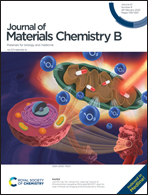Genome editing of PD-L1 mediated by nucleobase-modified polyamidoamine for cancer immunotherapy†
Abstract
Immune checkpoint blockade therapy against programmed death protein-1 and its ligand (PD-1/PD-L1) has been accepted as a promising approach to activate the immune system's anti-tumor response. Although small interfering RNA (siRNA) or antibodies can block the PD-1/PD-L1 pathway, the effect of this blockade is temporary and reversible. Here, we developed a nano-delivery system to achieve permanent disruption of the PD-L1 gene based on Clustered Regularly Interspaced Short Palindromic Repeats (CRISPR)/CRISPR-associated nuclease 9 (Cas9) gene editing technology. In this system, the CRISPR/Cas9 plasmid was delivered into melanoma B16F10 cells using a nucleobase-modified polyamidoamine (PAMAM) derivative namely AP-PAMAM, which was constructed through the modification with 2-amino-6-chloropurine. Meanwhile, the carrier could efficiently facilitate the endosomal escape of CRISPR/Cas9 plasmid and thereby inhibit PD-L1 expression in cancer cells. Moreover, the intravenous injection of AP-PAMAM/plasmid nanoparticles could recruit and activate CD8+ T cells at the tumor site, promoting the secretion of cytokines and the killing of tumor cells. Overall, this nano-delivery system for genome editing provided a promising strategy to block the PD-1/PD-L1 pathway and obtain effective tumor immunotherapy.



 Please wait while we load your content...
Please wait while we load your content...